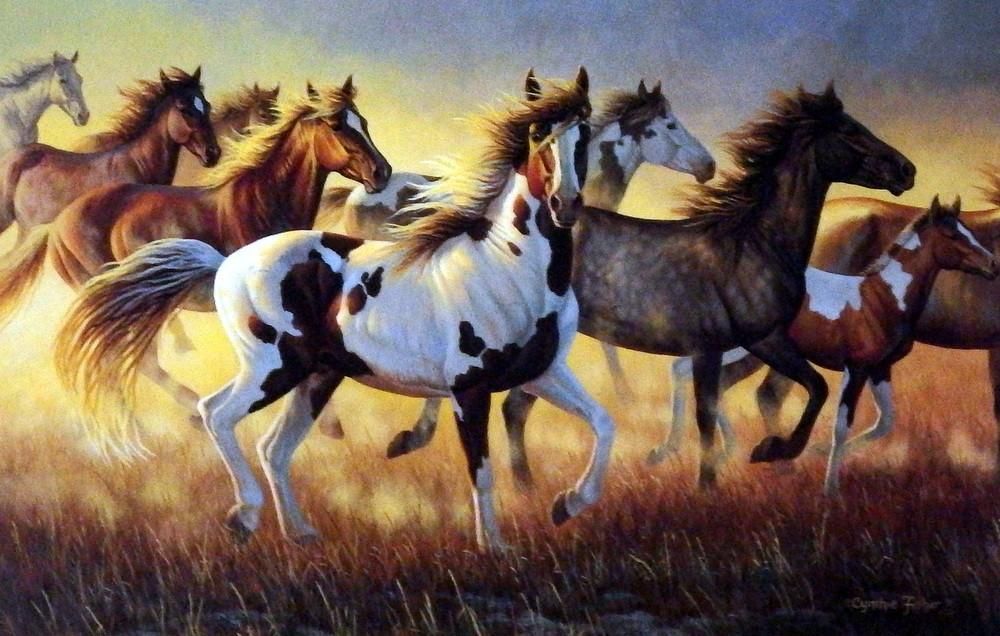Horse (wild)
| Species | hoofed mammal |
| No. Appearing | 5–30 |
| Behaviour | herd |
| Range | barrens, desert, steppe |
| Size | 14–17 hands at the withers |
| Weight | 800–1,100 lbs. |
| Intelligence | 3 |
| Armour Class | 7 |
| Hit Dice | 2 |
| Action Points | 6 |
| Max. Stride | 17 |
| THAC0 | 20 |
| Hp/Die | d4+d6 |
| Attack Forms | 1: bite; or 2: hoof |
| Damage | bite (1–3); hoof (1-8) |
| Special Attacks | back kick |
Wild Horses, more accurately described as "feral," are free-roaming descendants of once-domesticated animals. These horses originate from domesticated stock that either strayed, escaped or were deliberately released into the wild. Over generations, they have adapted to their environment, developing behaviours that closely resemble those of true wild horses.
Feral horses commonly organize into herds which are often structured around small harems led by a dominant mare. These herds include other mares, their foals and young horses of both genders. A single dominant stallion typically oversees the group, accompanied by subordinate males. Horses exhibit a strong fight-or-flight response, with their instinctive reaction to danger usually being to flee. However, when escape is not possible — particularly when defending their foals — they will stand their ground and actively protect themselves or their young.
In such cases, horses may rear up to strike with their forelegs, bite or deliver powerful kicks with their hind legs. Their ability to sense danger is heightened by acute hearing, wide peripheral vision and a keen sense of smell, allowing them to react swiftly to perceived threats. These defensive behaviours are most pronounced in dominant mares and stallions, who take on the role of protecting the herd.
Significant populations of free-roaming feral horses can be found in the grasslands of Iberia, southern Russia, the Americas and Turkestan. These populations are, to some extent, managed by druids, although limited gathering from the herds is allowed during late spring. Any significant take from these horses often requires permission from a forestal, the representative local nobility or presiding chieftains. Smaller, less-protected herds can be found throughout the world. The sage skill, domesticate horses, is necessary for the training and breaking of wild horses.
Advantages
Horses are generally non-aggressive, though they are likely to bite if approached too closely, particularly if they feel uneasy or cornered. When threatened and unable to flee, they may rear to attack, rising onto their hind legs in a vertical stance. In this position, the horse lifts its forehooves and strikes out with them before returning to all fours. In such situations, a horse typically focuses on a single target, striking the same opponent with a 3 in 4 chance, though it may split its attacks between two closely positioned threats if both are within range.
Wild horses employ the back kick, also known as a "double-barreled kick," as one of their most effective defensive maneuvers. This powerful attack is typically used when a threat is directly behind them, often when escape is not possible or when defending themselves or their herd. The horse will plant its front hooves firmly for balance, lift its hindquarters and deliver a swift, simultaneous strike with both hind hooves. The force of this kick is concentrated on a single target and can cause significant injury due to the combined weight and strength of the animal. The speed and precision of the back kick make it particularly dangerous. A horse's hindquarters contain immense muscle power, and the force generated can easily incapacitate or deter predators and other threats. The impact can break bones, knock down opponents or deliver enough pain to discourage further aggression.
Typically, a horse's back kick has a horizontal range of about 60 to 90 degrees, spanning roughly 30 to 45 degrees to either side of a line straight back from its body. This flexibility allows the horse to strike not only threats directly behind it but also those slightly off-center. After releasing a back kick, a horse's next action depends on the situation and perceived threat. Most often, the horse will flee, bolting forward to create distance from the danger, as flight is its primary survival instinct. If escape isn’t possible, the horse may pivot to face the threat, preparing to defend itself with rearing, biting, or another kick if necessary.
See also,
Bestiary
Horse (domestic)
